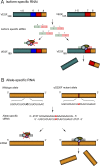Modulating the expression of disease genes with RNA-based therapy
- PMID: 17604456
- PMCID: PMC1904251
- DOI: 10.1371/journal.pgen.0030109
Modulating the expression of disease genes with RNA-based therapy
Abstract
Conventional gene therapy has focused largely on gene replacement in target cells. However, progress from basic research to the clinic has been slow for reasons relating principally to the challenges of heterologous DNA delivery and regulation in vivo. Alternative approaches targeting RNA have the potential to circumvent some of these difficulties, particularly as the active therapeutic molecules are usually short oligonucleotides and the target gene transcript is under endogenous regulation. RNA-based strategies offer a series of novel therapeutic applications, including altered processing of the target pre-mRNA transcript, reprogramming of genetic defects through mRNA repair, and the targeted silencing of allele- or isoform-specific gene transcripts. This review examines the potential of RNA therapeutics, focusing on antisense oligonucleotide modification of pre-mRNA splicing, methods for pre-mRNA trans-splicing, and the isoform- and allele-specific applications of RNA interference.
Conflict of interest statement
Competing interests. The authors have declared that no competing interests exist.
Figures



Similar articles
-
Progress toward therapy with antisense-mediated splicing modulation.Curr Opin Mol Ther. 2009 Apr;11(2):116-23. Curr Opin Mol Ther. 2009. PMID: 19330717 Free PMC article. Review.
-
Antisense oligonucleotide-based therapies for diseases caused by pre-mRNA processing defects.Adv Exp Med Biol. 2014;825:303-52. doi: 10.1007/978-1-4939-1221-6_9. Adv Exp Med Biol. 2014. PMID: 25201110 Review.
-
Making antisense of splicing.Curr Opin Mol Ther. 2005 Oct;7(5):476-82. Curr Opin Mol Ther. 2005. PMID: 16248283 Review.
-
Pharmacology of Antisense Drugs.Annu Rev Pharmacol Toxicol. 2017 Jan 6;57:81-105. doi: 10.1146/annurev-pharmtox-010716-104846. Epub 2016 Oct 10. Annu Rev Pharmacol Toxicol. 2017. PMID: 27732800 Review.
-
Transcript-Targeted Therapy Based on RNA Interference and Antisense Oligonucleotides: Current Applications and Novel Molecular Targets.Int J Mol Sci. 2022 Aug 9;23(16):8875. doi: 10.3390/ijms23168875. Int J Mol Sci. 2022. PMID: 36012138 Free PMC article. Review.
Cited by
-
The analytical landscape of static and temporal dynamics in transcriptome data.Front Genet. 2014 Feb 20;5:35. doi: 10.3389/fgene.2014.00035. eCollection 2014. Front Genet. 2014. PMID: 24600473 Free PMC article. Review.
-
Ablation of the UPR-mediator CHOP restores motor function and reduces demyelination in Charcot-Marie-Tooth 1B mice.Neuron. 2008 Feb 7;57(3):393-405. doi: 10.1016/j.neuron.2007.12.021. Neuron. 2008. PMID: 18255032 Free PMC article.
-
The intronic splicing code: multiple factors involved in ATM pseudoexon definition.EMBO J. 2010 Feb 17;29(4):749-60. doi: 10.1038/emboj.2009.397. Epub 2010 Jan 21. EMBO J. 2010. PMID: 20094034 Free PMC article.
-
The Emerging Role of Non-Coding RNAs in Drug Addiction.Front Genet. 2012 Jun 22;3:106. doi: 10.3389/fgene.2012.00106. eCollection 2012. Front Genet. 2012. PMID: 22737160 Free PMC article.
-
Use of Nanoparticles in Delivery of Nucleic Acids for Melanoma Treatment.Methods Mol Biol. 2021;2265:591-620. doi: 10.1007/978-1-0716-1205-7_41. Methods Mol Biol. 2021. PMID: 33704742
References
-
- Garcia-Blanco MA, Baraniak AP, Lasda EL. Alternative splicing in disease and therapy. Nat Biotechnol. 2004;22:535–546. - PubMed
-
- Huisman TH. Frequencies of common beta-thalassaemia alleles among different populations: Variability in clinical severity. Br J Haematol. 1990;75:454–457. - PubMed
-
- De Sandre-Giovannoli A, Bernard R, Cau P, Navarro C, Amiel J, et al. Lamin a truncation in Hutchinson-Gilford progeria. Science. 2003;300:2055. - PubMed
Publication types
MeSH terms
Substances
Grants and funding
LinkOut - more resources
Full Text Sources
Other Literature Sources
Medical

